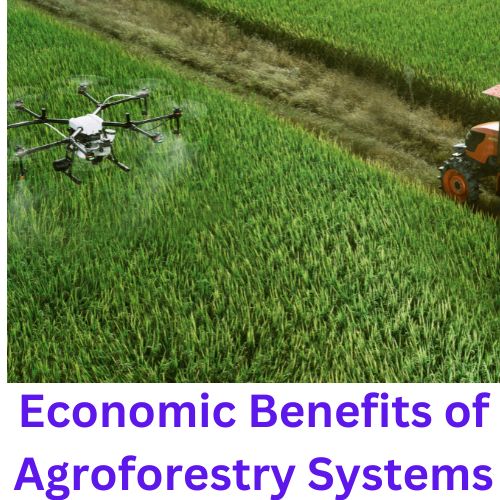Introduction
Agroforestry is an innovative and sustainable land-use system that combines tree cultivation with traditional agricultural practices. This harmonious integration of trees, crops, and sometimes livestock offers numerous economic benefits while promoting environmental conservation. This comprehensive exploration will delve deep into the economic advantages of agroforestry systems and why they are becoming increasingly popular among farmers and landowners worldwide.
Chapter 1: Understanding Agroforestry
Before we delve into the economic benefits of agroforestry, let’s gain a thorough understanding of what agroforestry is and how it works.
1.1. What is Agroforestry?
Agroforestry is a land management approach that combines the cultivation of trees or woody perennials with traditional agricultural practices. It deliberately integrates trees, crops, and sometimes livestock on the same land to create mutually beneficial interactions.
1.2. Types of Agroforestry Systems
Agroforestry systems come in various forms, each designed to meet specific ecological and economic goals. Some common types include:
1.2.1. Alley Cropping: In alley cropping, rows of trees are planted with crop alleys in between. The trees provide valuable resources like shade, mulch, and nutrient cycling to the crops, enhancing their productivity.
1.2.2. Silvopasture: Silvopasture combines trees, forage, and livestock to benefit all three components. The trees offer shade for the animals, while the animals provide nutrient-rich manure to support tree growth.
1.2.3. Forest Farming: Forest farming involves growing high-value specialty crops, such as ginseng or mushrooms, under the canopy of existing forests. This system maximizes the use of existing forestland for economic gain.
1.2.4. Windbreaks and Shelterbelts: These are linear plantings of trees or shrubs designed to protect crops and livestock from solid winds and reduce soil erosion.
Chapter 2: Diversified Income Streams
One of the primary economic benefits of agroforestry is the diversification of income streams for farmers. Let’s explore this aspect in detail.
2.1. Income from Multiple Sources
By incorporating trees into their agricultural landscapes, farmers can generate income from various sources. These sources include:
2.1.1. Timber Production: Trees planted in agroforestry systems can be harvested for timber, providing a valuable source of income. Sustainable timber management practices can ensure a continuous supply of wood.
2.1.2. Fruits and Nuts: Many agroforestry systems include fruit and nut trees that produce marketable crops. These trees can provide seasonal income and improve overall farm profitability.
2.1.3. Non-Timber Forest Products (NTFPs): Agroforestry offers opportunities to harvest NTFPs such as medicinal plants, mushrooms, honey, and aromatic resins. These products can be sold in local or niche markets, diversifying income streams.
2.1.4. Traditional Crop Yields: Besides trees and NTFPs, traditional crop yields may also increase in agroforestry systems, contributing to a farmer’s income.
2.2. Risk Mitigation
Diversifying income sources through agroforestry can reduce the financial risks associated with agriculture. Farmers who rely solely on a single crop or income source are vulnerable to market fluctuations and weather-related challenges. Agroforestry provides a safety net, ensuring that even if one income source is affected, others remain intact.
Chapter 3: Increased Crop Productivity
Agroforestry systems often lead to increased crop productivity due to various ecological advantages. Let’s explore these benefits in detail.
3.1. Shade and Wind Protection
The presence of trees in agroforestry systems offers several advantages to crops. Trees can provide shade, reducing plant stress during hot weather and preventing sunburn on fruit. They also act as windbreaks, protecting crops from strong winds that can damage or uproot them. These benefits result in improved crop health and higher yields.
3.2. Soil Fertility Enhancement
Agroforestry contributes to enhanced soil fertility through several mechanisms:
3.2.1. Nitrogen Fixation: Certain tree species, like legumes, have symbiotic relationships with nitrogen-fixing bacteria in their root nodules. This process adds nitrogen to the soil, benefiting neighboring crops.
3.2.2. Organic Matter Accumulation: Tree leaves and organic debris contribute to the accumulation of organic matter in the soil. This enriches soil structure and nutrient content.
3.2.3. Nutrient Cycling: Trees play a vital role in nutrient cycling by absorbing nutrients from deeper soil layers and making them available to crops through litter decomposition.
3.2.4. Reduced Erosion: The root systems of trees help bind soil particles, reducing erosion and soil loss, which can otherwise lead to reduced crop productivity.
3.3. Microclimate Modification
Trees modify the microclimate within agroforestry systems. They can moderate temperature extremes, reduce frost risk, and create more favorable conditions for crop growth. Such microclimate modification can extend the growing season and increase crop yields.
Chapter 4: Timber and Non-Timber Forest Products
Let’s delve into the economic potential of timber and non-timber forest products (NTFPs) within agroforestry systems.
4.1. Sustainable Timber Production
Agroforestry systems allow for sustainable timber production. Farmers can plant high-value timber species like mahogany, oak, or teak alongside other crops. Timber can be harvested when trees reach maturity, providing a substantial source of income. Sustainable management practices ensure the long-term viability of timber resources.
4.2. Non-Timber Forest Products (NTFPs)
Agroforestry systems offer a diverse range of NTFPs that can be harvested and sold for profit:
4.2.1. Medicinal Plants: Many agroforestry systems include medicinal plants with market demand. These plants can be cultivated and harvested, providing a valuable income source.
4.2.2. Mushrooms: Shady and moist conditions trees create are conducive to mushroom cultivation. Edible mushrooms like shiitake and oyster can be grown and sold.
4.2.3. Honey Production: Beekeeping in agroforestry systems can lead to honey production. Bees benefit from the diverse flora, producing unique and high-quality honey for sale.
4.2.4. Aromatic Resins: Some tree species in agroforestry systems produce aromatic resins like frankincense or myrrh, which have commercial value in perfumery and traditional medicine.
4.2.5. Specialty Fruits and Nuts: Agroforestry systems often include specialty fruit and nut trees that yield high-value products for local or niche markets.
